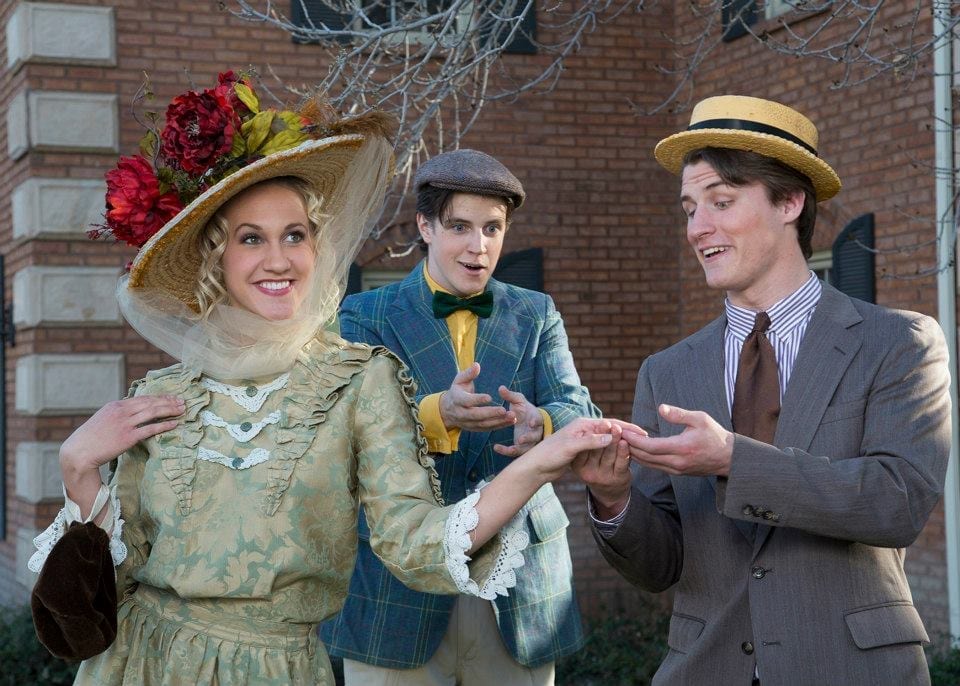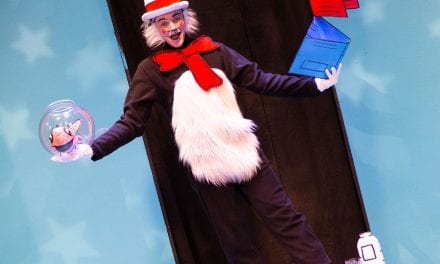OREM — No matter what your need is, Dolly Levi can meet it. In the opening scene of Hello, Dolly!, she offers her services to reduce varicose veins, pierce ears, and (most importantly) meddle in people’s business. The loveable character, originally created by Carol Channing, can be seen again in Utah this month at the SCERA Center for the Arts.
Hello, Dolly! is the 1964 Broadway musical superhit about the widowed Dolly Levi who is professional matchmaker who meddles in other people’s lives to help them fall in love with the perfect mate. Dolly decides to attempt the ultimate match: to convince the wealthy Horace Vandergelder to marry her. Along the way she matches up three other couples: Cornelius Hackl (the chief clerk at Horace’s store) and Irene Malloy (a New York City milliner), Barnaby Tucker (another employee of Horace’s) and Minnie Fay (Irene’s assistant), and the artist Ambrose Kemper and Ermengarde (Horace’s niece). Along the way, hijinks ensue as Horace tries to regain control of his employees, his niece, and his personal life.
The most notable aspect of the SCERA’s production is the high quality of the musical direction. Under the guidance of Martha Glissmeyer, every song in Jerry Herman‘s score sounded great. The vocals in “Put on Your Sunday Clothes,” the title song, and “Call on Dolly” were clear and crisp, and the tone quality in all of these group numbers was bright and clean. Moreover, the solo songs were sung in ways that emphasized the characters’ personalities, such as in “It Takes a Woman” and “So Long, Dearie.” On the other hand, the recorded music (usually a great strength at the SCERA) sounded like it was entirely recorded with a synthesizer and therefore had an artificial, tinny quality to it.
Director Jerry Elison has created a show that moves quickly from scene to scene and emphasizes the humor of Michael Stewart‘s script without seeming cartoonish. The opening scene, during which almost the entire cast swiftly enters and exits as they sing and playfully interact with Dolly, establishes Dolly as the nucleus of the play and conveys to the audience that this is going to be an interactive, fun ensemble. Elison also created great stage pictures during “It Takes a Woman” and “Motherhood America,” which made the show memorable. My only major disappointment in the direction was in the first act finale, “Before the Parade Passes By,” where the musical staging was staid and rigid.
Aiding Elison in the staging is choreographer Penny Colvin, who crated a lot of nice couples dancing in the ensemble from the very beginning of the show. Colvin’s work in “Elegance,” was probably my favorite choreography of the night; she kept every verse of the song entertaining because she constantly introduced new actions and steps for the four actors to do. I also appreciated how Cornelius’s movements gradually became more graceful during “Dancing,” an important song for the progression of the plot. In general, Colvin’s choreography wasn’t complicated, but she knows how to contribute to the story and not detract from it.

Left to right: Lauren Anderson as Irene Malloy, Marshall Madsen as Barnaby Tucker, and Jacom Clarkson as Cornelius Hackl.
Melissa Swingle plays Dolly in this production with a charm and determination that makes it clear why the character is a real Renaissance woman. Swingle has an enjoyable singing voice, and I was pleasantly surprised by her unique interpretations of “So Long, Dearie” and “Motherhood America,” during which she powerfully belted some of the musical phrases with ease and style. Although she was younger than most women cast as Dolly, Swingle balanced the wisdom of the character with Dolly’s playfulness in the hat shop and restaurant scenes. Eric Johnson played Horace Vandergelder, and had a solid grasp of how uncomfortable his character was with the loss of control that he experiences as the play progresses. However, I felt that Johnson’s performance had less of the variety than Swingle’s, and it would have been nice to get more diversity of facial expressions and vocal choices from Johnson. But I can’t ignore the fact that he was convincing as a crotchety old man, and by the end of the production I came to accept his performance and gave him some strong applause as he bowed.
Among the supporting actors was the entrancing Lauren Anderson, who played Irene Malloy. Anderson has a charisma on stage that naturally draws attention, and she makes the songs she sings seem like they naturally originate from her character. For example, Anderson’s first song, “Ribbons Down My Back,” had just a hint of seduction in it, an interpretation of the song that matches the Irene’s dialogue in the same scene. Anderson interacted well with her co-star Jacom Clarkson, who played Cornelius. Clarkson played his character with a great deal of honesty; Cornelius is who he is, which makes his decision to deceive Irene so that he can kiss her very sweet.
Deborah Bowman‘s costumes were a visual treat. Dolly’s iconic red dress was gorgeous, with exquisitely detail work and an elaborate bustle. The women’s hats in the production had a distinctive style that was completely appropriate to the 1890’s setting of the play. I also loved the stylish waiter costumes, which—along with the lighting and Dolly’s dress—helped to create a unified color scheme for the “Hello, Dolly!” song. The set (designed by Teri Griffin) was elaborate and efficiently provided for the variety of locations that the script calls for (e.g., a courtroom, a luxury restaurant with private dining rooms, a store). However, some of the set pieces seemed flat because of the lack of texturing.
Hello, Dolly! was at one time the longest running musical in Broadway history, and at the SCERA, it’s easy to see why. The easily hummable score and the witty dialogue are at the forefront of this community production, much to the credit of the creative staff. Even without a Broadway budget, Hello, Dolly! still has the power to attract new fans.







